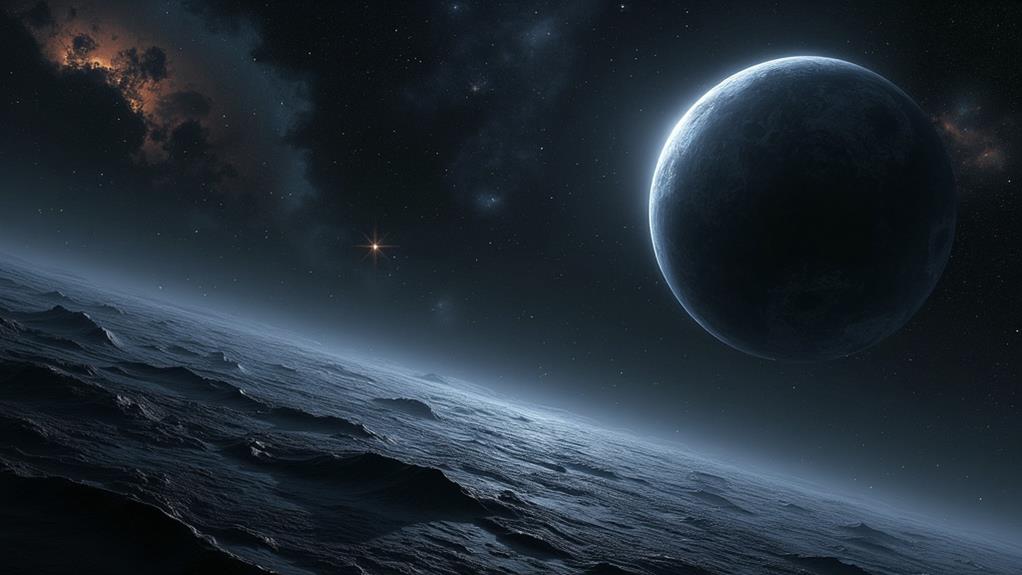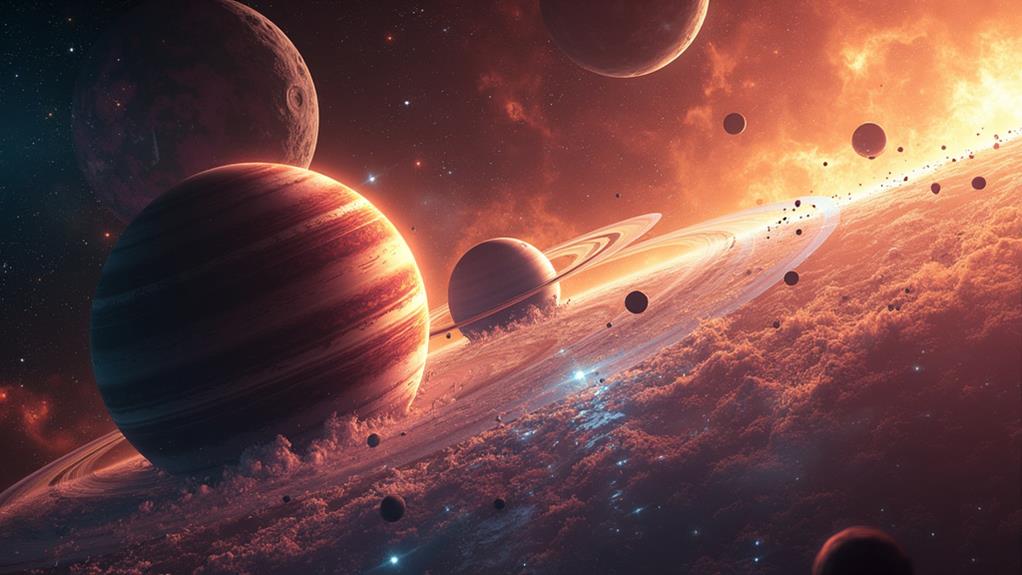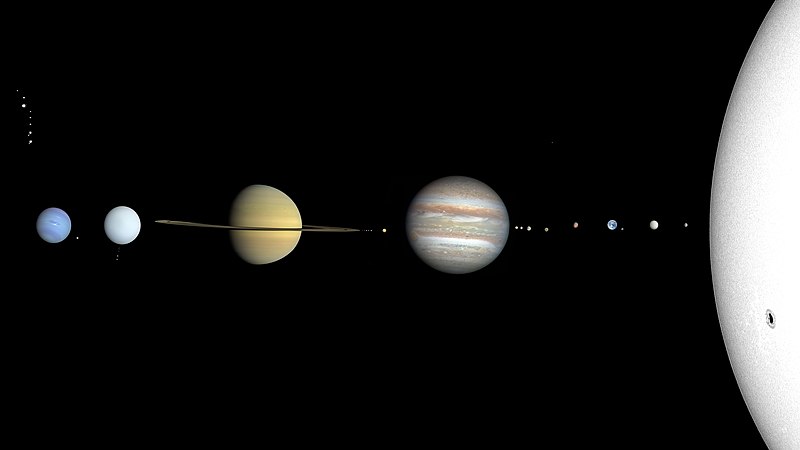Exoplanets With Unusual Orbits: Astonishing Finds

You're about to uncover exoplanets with some truly astonishing orbits. TIC 241249530 b has an incredibly eccentric orbit, moving from near its star to Earth's distance, while WASP-12b, a hot Jupiter, is distorted by its star's intense radiation. 55 Cancri e, another standout, might have a diamond interior and scorching surface temperatures. Rogue planets like OGLE-2016-BLG-1928 wander the galaxy without a host star, defying conventional planetary norms. These intriguing orbits not only improve our understanding of cosmic diversity but also reveal new insights into planetary formation and dynamics. Stick around to explore more about these extraordinary worlds.
Key Takeaways
- TIC 241249530 b's eccentricity of 0.94 creates an oblong orbit with retrograde motion.
- WASP-12b is a hot Jupiter, heavily distorted by intense stellar radiation.
- 55 Cancri e, a super-Earth, may have a diamond interior with extreme surface temperatures of around 2,700°C.
- Rogue planets like OGLE-2016-BLG-1928 drift through the Milky Way without a host star.
- KELT-9b, the hottest known exoplanet, has surface temperatures around 4,300°C, forming metallic clouds.
Unique Exoplanet Characteristics
With regard to unique exoplanet characteristics, the universe never ceases to amaze. Among these fascinating worlds, TIC 241249530 b stands out with an eccentricity of 0.94, making its orbit more oblong than any other known transiting planet. This cucumber-like orbit sets it apart from the more circular paths typically seen.
Hot Jupiters like WASP-12b also showcase remarkable traits. Located 600 light-years away, this exoplanet is heavily distorted due to its proximity to its star. The intense stellar radiation causes WASP-12b to swell and distort, putting it on a path to eventual disintegration.
Then there's 55 Cancri e, a super-Earth that captures attention with its unique characteristics. With a surface temperature of around 2,700°C and a high carbon content, it's believed to house a diamond interior, adding an exotic twist to its profile.
These exoplanets, with their unusual orbits and remarkable features, broaden our understanding of the cosmos. From TIC 241249530 b's eccentric path to WASP-12b's distorted shape and 55 Cancri e's potential diamond core, each one adds a new layer of intrigue to the study of exoplanets.
Extreme Weather Phenomena
Just as unique characteristics define many exoplanets, their extreme weather phenomena capture our imagination and challenge our understanding of planetary climates. Exoplanet WASP-76b exemplifies this with its iron rains. Due to extreme temperatures, iron vaporizes on the scorching dayside and condenses into iron rains on the cooler nightside. Likewise, HD 189733b experiences surface winds reaching 8,700 km/h, resulting in molten glass rains—silicate particles whipped through its atmosphere.
Upsilon Andromedae b demonstrates severe temperature variations, with dayside temperatures soaring to 2,500°C (4,532°F) and sub-freezing nightside conditions. This stark contrast is due to its unusual orbit and scorching proximity to its star. KELT-9b, the hottest known exoplanet, has surface temperatures around 4,300°C (7,792°F), creating bizarre metallic clouds in its atmosphere.
Moreover, LHS 3844b features a lava-covered surface with temperatures around 1,000°C (1,832°F), illustrating the extreme conditions on some rocky exoplanets. These exotic weather phenomena result from planetary migration and unusual orbits, often bringing these worlds scorchingly close to their stars. The study of these exoplanets provides invaluable insights into the diverse and extreme climates beyond our solar system.
Rogue and Isolated Planets

Rogue planets, those enigmatic wanderers of the cosmos, drift through the Milky Way without the gravitational anchor of a host star. These rogue exoplanets, like OGLE-2016-BLG-1928, navigate the galaxy in isolation, often having been ejected from their original stellar systems. The ejection process results from complex gravitational interactions, underscoring the chaotic nature of planetary formation dynamics.
Take OT44, for instance, a massive rogue world about 11 times the mass of Jupiter. It's characterized by its dark, cold environment, a stark contrast to the warmth provided by a host star. These isolated planets vary widely in temperature and composition, influenced by their unique formation histories and the environments they've traversed since becoming free-floating.
Detecting these rogue exoplanets presents a significant challenge, particularly for Earth-sized rogue planets. Their lack of a host star makes traditional detection methods less effective, complicating efforts to study them. However, each revelation offers valuable insights into the dynamics of planetary systems and the violent processes that can lead to a planet's ejection.
Understanding rogue planets doesn't just expand our knowledge of isolated planets; it also enriches our comprehension of the intricate ballet of forces shaping our universe.
Discovery Techniques
To uncover exoplanets with unusual orbits, astronomers rely on a suite of sophisticated techniques. The Transit Method, for instance, is a key approach where you detect dips in starlight as a planet passes in front of its host star. This method allows you to identify unique orbital characteristics, making it easier to spot those exoplanets with unusual orbits.
Another powerful technique is the Radial Velocity Method. By measuring the wobble of stars caused by the gravitational pull of orbiting planets, you can gain insights into their mass and orbital eccentricity. This method is particularly useful for understanding the dynamics of these fascinating worlds.
Gravitational microlensing is also employed to unveil rogue planets or those with atypical orbits. This technique involves observing the bending of light around massive objects, revealing how these planets interact with their surroundings.
Here are three key points to remember:
- Transit Method: Detects dips in starlight, revealing unique orbital characteristics.
- Radial Velocity Method: Measures stellar wobble to understand mass and eccentricity.
- Gravitational microlensing: Observes light bending to identify rogue or atypically orbiting planets.
Advanced instruments like the NEID spectrograph further confirm these revelations by analyzing light shifts due to gravitational influences, providing a detailed look at stellar positions and the exoplanets they host.
Notable Exoplanet Findings

Building on the revealing techniques previously discussed, let's explore some notable exoplanet findings that have captivated astronomers. Among these, TIC 241249530 b stands out due to its strikingly unusual orbit. With an eccentricity of 0.94, this exoplanet's path is more cucumber-shaped than circular, surpassing all known transiting planets. What makes TIC 241249530 b even more fascinating is its retrograde motion, as it orbits its host star in the opposite direction of the star's rotation, showcasing unique orbital dynamics.
TIC 241249530 b isn't just intriguing because of its orbit. This gas giant has a mass approximately five times that of Jupiter and is currently in a pre-migration phase, suggesting it may soon become a hot Jupiter. Its orbital path varies dramatically, ranging from about ten times closer to its star than Mercury to Earth's distance, highlighting significant variability.
The identification of TIC 241249530 b offers valuable insights into the migration processes of gas giants. Studying how such exoplanets evolve from eccentric orbits to tighter, circular ones improves our understanding of hot Jupiters. These findings underscore the diversity and complexity of exoplanets and their orbital behaviors.
Future Research Directions
As astronomers look ahead, they're gearing up to investigate deeper into the mysteries of exoplanets with unusual orbits, such as TIC 241249530 b. Future research aims to untangle the mechanisms behind planetary migration and the formation of hot Jupiters. With the James Webb Space Telescope, you'll gain unprecedented insights into atmospheric dynamics during close passages to stars, shedding light on how extreme orbits impact exoplanet atmospheres.
Expect continued observations of eccentric orbits like TIC 241249530 b to reveal evolutionary pathways for gas giants, challenging existing theories of planetary formation. To achieve thorough research, collaborations among institutions, such as Penn State University and MIT, will be essential. These partnerships will facilitate the sharing of findings and methodologies, enriching the general understanding of unusual exoplanetary orbits.
Here's what you can anticipate:
- Enhanced understanding of planetary migration: Untangle how and why exoplanets shift their positions within their systems.
- Insights into atmospheric dynamics: Investigate how eccentric orbits affect the atmospheres of hot Jupiters during close star passages.
- Evolutionary pathways of gas giants: Challenge and refine current theories about their formation and development.
Frequently Asked Questions
What Is the Strangest Exoplanet?
Imagine a planet straight out of a Jules Verne novel! The strangest exoplanet might be TIC 241249530 b. It flaunts peculiar atmospheres and extreme temperatures due to its eccentric rotations and unusual compositions. Its massive size and tidal locking make it even more fascinating. Add in retrograde motion and distant orbits, and you've got a bizarre world. Tidal forces and magnetic fields only add to its mystery. It's truly an astronomical oddity!
Which Planet Has a Weird Orbit?
You'll find that TIC 241249530 b has one of the weirdest orbits. Its unusual eccentricities and highly elliptical path make it stand out. It even shows retrograde motion, orbiting opposite to its host star's rotation. This exoplanet's extreme tilts and chaotic dynamics result from gravitational interactions and orbital resonances, likely influenced by close binaries or multi-star systems. Studying it reveals insights into planetary migration and the formation of hot Jupiters.
Why Is Tres 2b so Dark?
TrES-2b is so dark because its atmospheric composition causes extreme light absorption. The planet's surface temperature, reaching 1,800°F, contributes to heat retention and unusual reflection characteristics. These color anomalies result from the unique gases and compounds in its atmosphere. Its classification as a hot Jupiter and its close orbital mechanics to its star intensify these effects. Unveiling methods have highlighted these stellar interactions, deepening our understanding of such phenomena.
What Extrasolar Planet Discoveries Were Initially Surprising?
You've probably heard about the unexpected revelations of exoplanets with bizarre orbits, right? Some have eccentric trajectories that make them look like cosmic boomerangs. Others exhibit planetary anomalies like surprising compositions or rogue planets with unique formations. Their unexpected climates and orbital resonances are mind-blowing. These unusual characteristics defy our understanding, like finding a square peg in a round hole. Each one challenges our theories and sparks endless curiosity!




